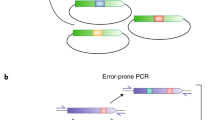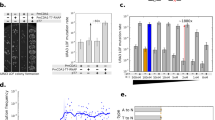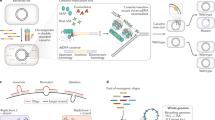Abstract
We introduce a method of in vitro recombination or “DNA shuffling” to generate libraries of evolved enzymes. The approach relies on the ordering, trimming, and joining of randomly cleaved parental DNA fragments annealed to a transient polynucleotide scaffold. We generated chimeric libraries averaging 14.0 crossovers per gene, a several-fold higher level of recombination than observed for other methods. We also observed an unprecedented four crossovers per gene in regions of 10 or fewer bases of sequence identity. These properties allow generation of chimeras unavailable by other methods. We detected no unshuffled parental clones or duplicated “sibling” chimeras, and relatively few inactive clones. We demonstrated the method by molecular breeding of a monooxygenase for increased rate and extent of biodesulfurization on complex substrates, as well as for 20-fold faster conversion of a nonnatural substrate. This method represents a conceptually distinct and improved alternative to sexual PCR for gene family shuffling.
This is a preview of subscription content, access via your institution
Access options
Subscribe to this journal
Receive 12 print issues and online access
$209.00 per year
only $17.42 per issue
Buy this article
- Purchase on Springer Link
- Instant access to full article PDF
Prices may be subject to local taxes which are calculated during checkout






Similar content being viewed by others
References
Kikuchi, M., Ohnishi, K. & Harayama, S. An effective family shuffling method using single-stranded DNA. Gene 243, 133–137 (2000).
Lorimer, I.A. & Pastan, I. Random recombination of antibody single chain Fv sequences after fragmentation with DNaseI in the presence of Mn2+. Nucleic Acids Res. 23, 3067–3068 (1995).
Shao, Z., Zhao, H., Giver, L. & Arnold, F.H. Random-priming in vitro recombination: an effective tool for directed evolution. Nucleic Acids Res. 26, 681–683 (1998).
Stemmer, W.P. DNA shuffling by random fragmentation and reassembly: in vitro recombination for molecular evolution. Proc. Natl. Acad. Sci. USA 91, 10747–10751 (1994).
Stemmer, W.P. Rapid evolution of a protein in vitro by DNA shuffling. Nature 370, 389–391 (1994).
Zhao, H. & Arnold, F.H. Optimization of DNA shuffling for high fidelity recombination. Nucleic Acids Res. 25, 1307–1308 (1997).
Levichkin, I.V., Shul'ga, A.A., Kurbanov, F.T. & Kirpichnikov, M.P. A new method of designing hybrid genes—the homolog recombination method. Mol. Biol. (Mosk). 29, 983–991 (1995).
Zhao, H., Giver, L., Shao, Z., Affholter, J.A. & Arnold, F.H. Molecular evolution by staggered extension process (StEP) in vitro recombination. Nat. Biotechnol. 16, 258–261 (1998).
Piddington, C.S., Kovacevich, B.R. & Rambosek, J. Sequence and molecular characterization of a DNA region encoding the dibenzothiophene desulfurization operon of Rhodococcus sp. strain IGTS8. Appl. Environ. Microbiol. 61, 468–475 (1995).
Fridrick, C. et al. Isolation and characterization of a biodesulfurizing Nocardia sp. In Abstracts of the 99th General Meeting of the American Society for Microbiology, Abstr. O–23 500. (American Society for Microbiology, Washington, DC; 1999).
Levinson, W., Coco, W., Crist, M., Fridrick, C. & Pienkos, P. Directed evolution of DBT monooxygenase using growth on biodesulfurized diesel oil as a selection and screening strategy. In Abstracts of the Annual Meeting of the Society for Industrial Microbiology, San Diego, Abstr. P31 128. (Society for Industrial Microbiology, Fairfax, VA; 2000).
Eckert, K.A. & Kunkel, T.A. The fidelity of DNA polymerase used in the polymerase chain reactions. In PCR. A practical approach. (eds McPherson, M.J., Quirke, P. & Taylor, G.R.) 225–244 (IRL Press, Washington, DC; 1991).
Arensdorf, J.J. & Pienkos, P. Biotransformations of model sulfur compounds by Rhodococcus. In Abstracts of the 100th General Meeting of the American Society for Microbiology, Los Angeles, Abstr. O–24 501. (American Society for Microbiology, Washington, DC; 2000).
Lei, B. & Tu, S.C. Gene overexpression, purification, and identification of a desulfurization enzyme from Rhodococcus sp. strain IGTS8 as a sulfide/sulfoxide monooxygenase. J. Bacteriol. 178, 5699–5705 (1996).
Denome, S.A., Oldfield, C., Nash, L.J. & Young, K.D. Characterization of the desulfurization genes from Rhodococcus sp. strain IGTS8. J. Bacteriol. 176, 6707–6716 (1994).
Oldfield, C., Pogrebinsky, O., Simmonds, J., Olson, E.S. & Kulpa, C.F. Elucidation of the metabolic pathway for dibenzothiophene desulphurization by Rhodococcus sp. strain IGTS8 (ATCC 53968). Microbiology 143, 2961–2973 (1997).
Charlesworth, B. Mutation-selection balance and the evolutionary advantage of sex and recombination. Genet. Res. 55, 199–221 (1990).
Felsenstein, J. The evolutionary advantage of recombination. Genetics 78, 737–756 (1974).
Felsenstein, J. & Yokoyama, S. The evolutionary advantage of recombination. II. Individual selection for recombination. Genetics 83, 845–859 (1976).
Kondrashov, A.S. Deleterious mutations as an evolutionary factor. 1. The advantage of recombination. Genet. Res. 44, 199–217 (1984).
Minshull, J. & Stemmer, W.P. Protein evolution by molecular breeding. Curr. Opin. Chem. Biol. 3, 284–290 (1999).
Ostermeier, M., Nixon, A.E. & Benkovic, S.J. Incremental truncation as a strategy in the engineering of novel biocatalysts. Bioorg. Med. Chem. 7, 2139–2144 (1999).
Crameri, A., Raillard, S.A., Bermudez, E. & Stemmer, W.P. DNA shuffling of a family of genes from diverse species accelerates directed evolution. Nature 391, 288–291 (1998).
Kumamaru, T., Suenaga, H., Mitsuoka, M., Watanabe, T. & Furukawa, K. Enhanced degradation of polychlorinated biphenyls by directed evolution of biphenyl dioxygenase. Nat. Biotechnol. 16, 663–666 (1998).
Christians, F.C., Scapozza, L., Crameri, A., Folkers, G. & Stemmer, W.P. Directed evolution of thymidine kinase for AZT phosphorylation using DNA family shuffling. Nat. Biotechnol. 17, 259–264 (1999).
Barany, F. The ligase chain reaction in a PCR world. PCR Methods Appl. 1, 5–16 (1991).
Luo, J., Bergstrom, D.E. & Barany, F. Improving the fidelity of Thermus thermophilus DNA ligase. Nucleic Acids Res. 24, 3071–3078 (1996).
Shuman, S. Vaccinia virus DNA ligase: specificity, fidelity, and inhibition. Biochemistry (Mosc). 34, 16138–16147 (1995).
Sriskanda, V. & Shuman, S. Specificity and fidelity of strand joining by Chlorella virus DNA ligase. Nucleic Acids Res. 26, 3536–3541 (1998).
Kwok, S. et al. Effects of primer–template mismatches on the polymerase chain reaction: human immunodeficiency virus type 1 model studies. Nucleic Acids Res. 18, 999–1005. (1990).
Coco, W.M., Crist, M., Levinson, W.E. & Darzins, A. A novel method of gene family shuffling relieves simultaneous bottlenecks in a highly engineered pathway. In Abstracts of the Society for Industrial Microbiology Annual Meeting, San Diego, Abstr. P30 97. (Society for Industrial Microbiology, Fairfax, VA; 2000).
Moore, J.C., Jin, H.M., Kuchner, O. & Arnold, F.H. Strategies for the in vitro evolution of protein function: enzyme evolution by random recombination of improved sequences. J. Mol. Biol. 272, 336–347 (1997).
Sambrook, J., Fritsch, E.F. & Maniatis, T. Molecular Cloning, Edn. 2. (Cold Spring Harbor Laboratory Press, Plainview, New York; 1989).
Liu, W.E., Tan, D. & Zhang, Z. Serum HBV DNA detected by polymerase chain reaction with dUTP/uracil– DNA glycosylase. Hunan I. Ko Ta Hsueh Hsueh Pao 23, 278–280 (1998).
Lyamichev, V., Brow, M.A. & Dahlberg, J.E. Structure-specific endonucleolytic cleavage of nucleic acids by eubacterial DNA polymerases. Science 260, 778–783 (1993).
Bigey, F., Grossiord, B., Chan Kuo Chion, C.K., Arnaud, A. & Galzy, P. Brevibacterium linens pBL33 and Rhodococcus rhodochrous pRC1 cryptic plasmids replicate in Rhodococcus sp. R312 (formerly Brevibacterium sp. R312). Gene 154, 77–79 (1995).
O'Connor, K.E., Dobson, A.D. & Hartmans, S. Indigo formation by microorganisms expressing styrene monooxygenase activity. Appl. Environ. Microbiol. 63, 4287–4291 (1997).
Acknowledgements
We thank the Enchira high-throughput screening and analytical chemistry groups for expert technical assistance; G. Mrachko, B. Blattmann, J. Arensdorf, E. Lange, J. Blanton, B. Folsom, U. Coco, J. Bryson, and L. Encell for developing additional assays, assistance with figures, statistical analyses and critical comments on the manuscript.
Author information
Authors and Affiliations
Corresponding author
Rights and permissions
About this article
Cite this article
Coco, W., Levinson, W., Crist, M. et al. DNA shuffling method for generating highly recombined genes and evolved enzymes. Nat Biotechnol 19, 354–359 (2001). https://doi.org/10.1038/86744
Received:
Accepted:
Issue Date:
DOI: https://doi.org/10.1038/86744
This article is cited by
-
Bypassing evolutionary dead ends and switching the rate-limiting step of a human immunotherapeutic enzyme
Nature Catalysis (2022)
-
Engineering of a fluorescent chemogenetic reporter with tunable color for advanced live-cell imaging
Nature Communications (2021)
-
Identification of Thermus aquaticus DNA polymerase variants with increased mismatch discrimination and reverse transcriptase activity from a smart enzyme mutant library
Scientific Reports (2019)
-
Adeno-associated virus as a gene therapy vector: strategies to neutralize the neutralizing antibodies
Clinical and Experimental Medicine (2019)
-
Creating a more robust 5-hydroxymethylfurfural oxidase by combining computational predictions with a novel effective library design
Biotechnology for Biofuels (2018)



